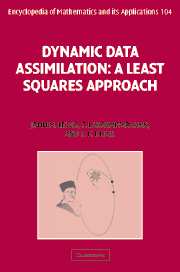Book contents
- Frontmatter
- Contents
- Preface
- Acknowledgements
- PART 1 GENESIS OF DATA ASSIMILATION
- PART II DATA ASSIMILATION: DETERMINISTIC/STATIC MODELS
- PART III COMPUTATIONAL TECHNIQUES
- PART IV STATISTICAL ESTIMATION
- PART V DATA ASSIMILATION: STOCHASTIC/STATIC MODELS
- 18 Data assimilation – static models: concepts and formulation
- 19 Classical algorithms for data assimilation
- 20 3DVAR: a Bayesian formulation
- 21 Spatial digital filters
- PART VI DATA ASSIMILATION: DETERMINISTIC/DYNAMIC MODELS
- PART VII DATA ASSIMILATION: STOCHASTIC/DYNAMIC MODELS
- PART VIII PREDICTABILITY
- Epilogue
- References
- Index
18 - Data assimilation – static models: concepts and formulation
from PART V - DATA ASSIMILATION: STOCHASTIC/STATIC MODELS
Published online by Cambridge University Press: 18 December 2009
- Frontmatter
- Contents
- Preface
- Acknowledgements
- PART 1 GENESIS OF DATA ASSIMILATION
- PART II DATA ASSIMILATION: DETERMINISTIC/STATIC MODELS
- PART III COMPUTATIONAL TECHNIQUES
- PART IV STATISTICAL ESTIMATION
- PART V DATA ASSIMILATION: STOCHASTIC/STATIC MODELS
- 18 Data assimilation – static models: concepts and formulation
- 19 Classical algorithms for data assimilation
- 20 3DVAR: a Bayesian formulation
- 21 Spatial digital filters
- PART VI DATA ASSIMILATION: DETERMINISTIC/DYNAMIC MODELS
- PART VII DATA ASSIMILATION: STOCHASTIC/DYNAMIC MODELS
- PART VIII PREDICTABILITY
- Epilogue
- References
- Index
Summary
In this opening chapter of Part V we develop the basic concepts leading to the formulation of the so-called data assimilation problem for static models. This problem arises in a wide variety of application domains and accordingly it goes with different terminologies that are unique to an application domain. For example, in oceanography and geological exploration, it is known as the inverse problem. In meteorology, this is known as the retrieval problem, objective analysis, three dimensional variational assimilation (3DVAR) problem, to mention a few. Henceforth, we use the term static data assimilation problem, retrieval problem, and inverse problem interchangeably. Despite these differences in the origin and the peculiarities of the labels, there is a common mathematical structure – a unity in diversity – that underlie all of these problems. The primary aim of this chapter is to develop this common framework. In Part VI we develop the data assimilation for dynamic models.
In Section 18.1, we describe the basic building blocks leading to the statement of the data assimilation problem for the static model. It turns out that this problem is intrinsically under-determined (where the number n of unknown variables is larger than the number, m of equations) which in turn implies that the solution space has a large degree of freedom (equal to n–m) leading to infinitely many solutions. Any attempt to induce uniqueness of the solution calls for the reduction of the dimensionality of the solution space. This is achieved by a general technique that is called regularization. A comprehensive review of the various regularization techniques that are commonly used is given in Section 18.2.
- Type
- Chapter
- Information
- Dynamic Data AssimilationA Least Squares Approach, pp. 285 - 299Publisher: Cambridge University PressPrint publication year: 2006



